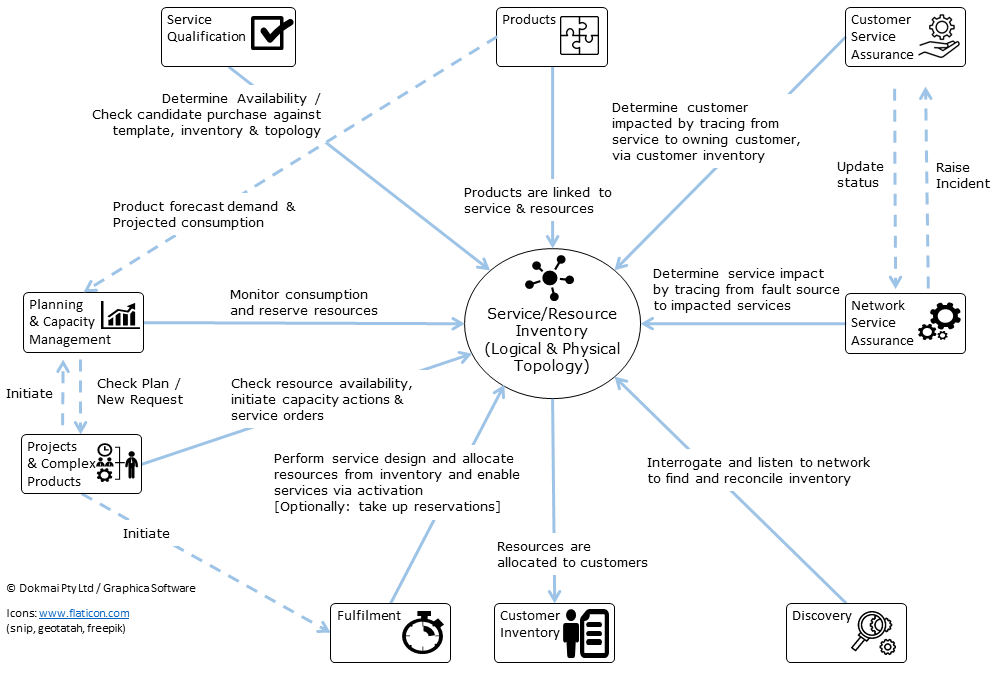Telco Inventory & Topology - Enabler for Automation
Inventory & Topology are central data constructs required to support core telecommunications processes

Over 10 years ago I created an architecture diagram to illustrate the key role that inventory plays within telecommunications processes. Since that time there have been various updates to this, but these have been mostly on the graphic rendition not the core idea.
The core idea is that nearly every telcommunications process needs to use inventory data to complete its process. The consistency of this model illustrates a common finding of difference in results and analysis done by data modellers than process designers. This has found that the data models tend to vary much less over time than the processes.
The model is illustrated here:

The surprising thing is that while the role of inventory and topology is so central, the impact of TmForum Process Model structure: Fullfilment, Assurance & Billing has been that these processes and the systems that support them have all been built and sold as seperate applications.
The flow through impact of this is that data is distributed across a number of systems and complex systems integration has had to be done to redistribute the data and / or provide central respositories of inventory.
This distributed approach does not lend itself to "extreme automation", a goal within telcos to bring down cost of operation and flow through "cost per bit". A new approach to network and services life cycle management is required, even more so with introduction of Virtual Network Functions (VNF) and Software Defined Networks (SDN). With SDN & NFV the life-time of virtual network elements and logical networks that they create is much shorter and much more dynamic. Having a real time single view of network inventory that can work across physical and logical topology is essential to deal with this.
The technology enablers to achieve these aims are: graph & time series databases, event streams for telemetry and micro-services and components based architecture to wire this all together. All of these underlying enabling technologies are available through Open Source projects. The validity of the model is evident within ONAP initiative which has "Active & Available Inventory" (A&AI) as central component within its architecture.
The need is as clear now as it was ten years ago and many vendors are offering various solutions aligned with the ambition. It is unlikely that the result will be achieved by grafting more systems and integration onto existing traditional TmForum partitioned Fulfilment & Assurance systems.
In reviewing potential candidate solution, whether these are built from Open Source components or being sold as turn-key solutions, it is worth having a look into the bowels of its inventory & topology support to determine if can meet the objectives now outlined in various "Programmable Network", "Closed Loop Assurance" and "Autonomic Computer / Networking" papers.
This will help to determine the future flexibility of the solution, as traditional process driven fullfilment systems are proven to be very fragile to changes in the network topology. This fragility to change is key cost contributor in telco Operational Support Systems (OSS).
References:
TmForum - Business Process Model
Appledore Research - Closed Loop and the New Role of Assurance, a paper that provides a good articulation of network automation ambitions
Autonomic Computing - an IBM research initiative from 2001 that defined the aspirations for automation of systems management including: Self Configuration, Self Healing, Self Optimising and Self Protecting
SDN - Software Defined Networking has many variations the most common being within data centre networking
NFV - Network Functional Virtualisation, ETSI provides the essential definitions
ONAP - ambitous Open Source project to provide a "platform for real-time, policy-driven orchestration and automation of physical and virtual network functions"
Fulfilment Systems Network Topology Sensitivity - authors research as as leader of Enterprise Architecture team at large telco.
NOTE 1: The motivation for shift from Value Chain, to Value Streams and Value Nets and Component modelling techniques is due to impact of out sourcing, specialisation and dis-intermediation which ripples through as having large impact on process models. See "Value Chains - A Great Tool for Scoping and Positioning" in "Just Enough Architecture" pages for additional references.
NOTE 2: Picture is an "unknot", lets unknot telco processes... ;-)
